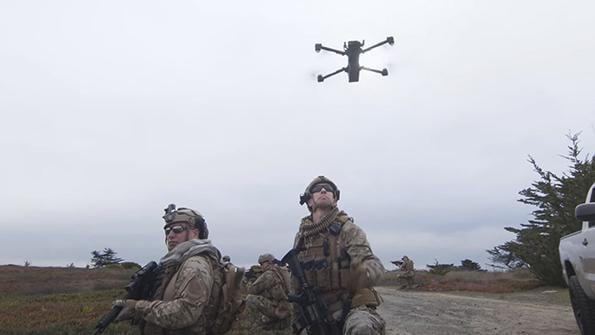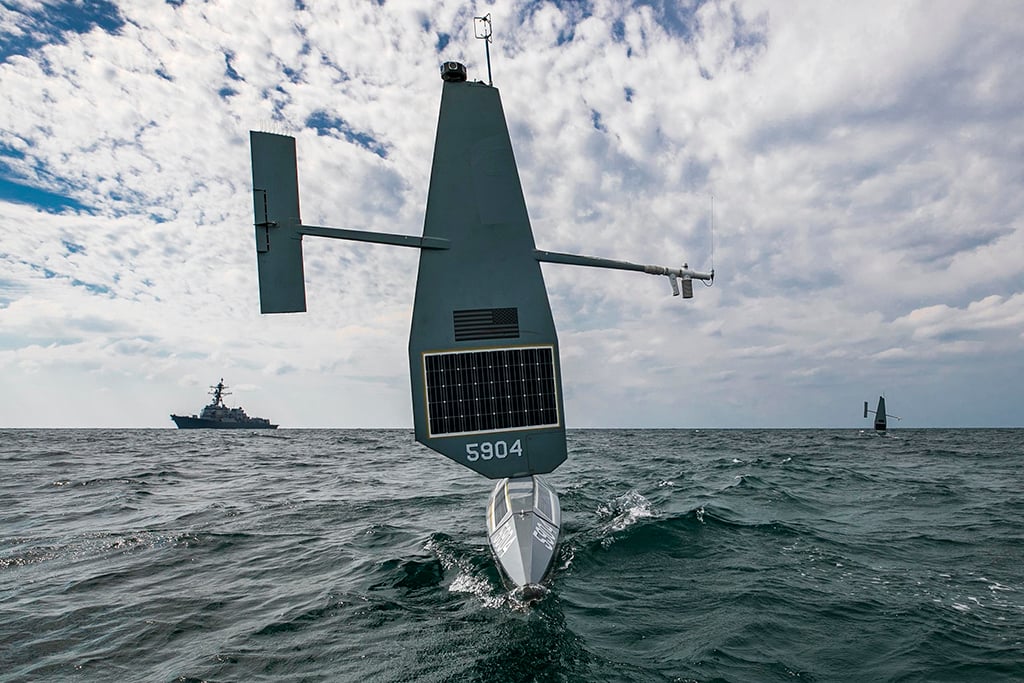
The U.S. Army has ordered 1,000 RQ-28 drones from Skydio and plans to award a competitive follow-on contract next spring for thousands more.
A new operational concept within the U.S. Indo-Pacific Command proposes to use a horde of drones to turn the Taiwan Strait into a “hellscape” if China attempts to invade Taiwan.
To realize that vision, the Defense Department has created several new efforts to solve the industrial, bureaucratic and command-and-control issues posed by unleashing thousands of drones simultaneously into the air, water and land around the roughly 100-nm channel between mainland China and Taiwan.
- The concept’s plans draw on Ukraine lessons
- DARPA supports Replicator with new autonomy program
The multiple projects, including the Pentagon’s recently announced Replicator and DARPA’s Rapid Experimental Missionized Autonomy (REMA) programs, seek to enhance and accelerate the programs of record already underway by each of the armed services to field tens of thousands of drones—including uncrewed air vehicles (UAV), uncrewed surface vessels (USV) and uncrewed ground vehicles—in the next several years.
As the Army leadership prepares to address the Association of the U.S. Army’s Annual Meeting that begins Oct. 9, the service’s acquisition officials are working behind the scenes to offer several ongoing drone acquisition programs for the Pentagon’s new fast-tracking and capability upgrade efforts, such as Replicator and REMA.
Speaking to reporters on Sept. 20, Doug Bush, the Army’s assistant secretary for acquisition, logistics and technology, said the service is working with the Office of the Secretary of Defense to understand how the existing programs could be included in the Replicator effort, but added that he hopes such a move would result in additional funding for the ongoing programs.
“In the unmanned aircraft space—[which is] especially where I think we could go faster—we’re limited by funding at this point,” Bush said. “But I think we’ve got some good systems that with more funding and some help on accelerating the process, the Army absolutely could contribute to the overall Replicator efforts.”
Heeding lessons from the Russia--Ukraine war, the Army already plans to award a contract next spring for up to 12,000 small quadcopter drones under the Short-Range Reconnaissance (SRR) program. Meanwhile, efforts continue to field thousands of Air-Launched Effects (ALE) as part of the Future Attack Reconnaissance Aircraft ecosystem of sensors and munitions. That ecosystem includes the tube-launched ALE-Small, which includes uncrewed aircraft systems (UAS) such as the Anduril Altius, and ALE-Large, a more secretive project that is known to involve at least UAS such as the L3Harris Technologies Red Wolf.
The Army programs would add to thousands of more drones of all sizes and performance levels in development or production across the U.S. military. In the conflicts in Iraq and Afghanistan of the last two decades, only dozens of uncrewed systems were in operation at any single time. In the decade ahead, thousands of drones could perform missions simultaneously. The transition is being informed by ongoing experiments such as the Navy’s Task Force 59 and the Air Force’s Task Force 99.
Lessons from those experiments have been folded into Hellscape, an operating concept developed over several years in secret. Adm. John Aquilino, commander of Indo-Pacific Command, revealed the idea in cryptic fashion on Aug. 28 at the Emerging Technologies for Defense Conference and Exhibition.
“The components in Indo-Pacom have been experimenting for the past 5-10 years with many of those unmanned capabilities. Those will be an asymmetric advantage,” Aquilino said. “So operational concepts that we’re working through are going to help amplify our advantages in this theater. There is a term, ‘Hellscape,’ that we use.”
The concept appears to mark a departure from operating concepts focused on employing limited numbers of expensive and exquisite weapon systems against an array of enemy targets. Naval attacks by Ukraine’s military have shown the power of weaponizing thousands of disposable, commercial drones against enemy formations, as well as targeting enemy ships in the Black Sea with large numbers of crude USVs that function like an overwhelming salvo of guided torpedoes.
Any invasion of Taiwan by China would require transporting an amphibious invasion force across the strait. The transit would expose dozens or even hundreds of large ships to drone attacks from the time they are loaded in port until the troops attempt to disembark along the Taiwanese coast. Modern naval ships are equipped with a range of defensive countermeasures to thwart a limited number of attacks from drones, torpedoes and anti-ship missiles. But the Hellscape concept proposes a way to overwhelm those countermeasures with dozens or hundreds of simultaneous drone attacks.

“I think [Hellscape] is creating a chaotic, unpredictable situation in the Taiwan Strait using unmanned systems—mostly surface systems, but maybe also some undersea systems and ones that are relatively inexpensive,” Bryan Clark, a former Navy submariner and now the director of the Center for Defense Concepts and Technology at the Hudson Institute, told Aviation Week.
“They’re taking the cue . . . from what the Ukrainians have done and [asking], ‘Can we apply that model in the Taiwan Strait?’ Because you’ve got a similar, kind of, fish-in-a-barrel sort of opportunity,” Clark added.
The concept may not be unique to the Indo-Pacific Command. Seeking to bolster asymmetric defensive capabilities against a Chinese amphibious invasion, the 2023 National Defense Report published on Sept. 12 by Taiwan’s defense ministry calls for buying 7,000 commercial drones and 700 military-grade UAVs in the next five years.
Similarly, the U.S. Defense Department unveiled the Replicator concept in late August, calling for fielding thousands of “attritable” drones across all domains within 18-24 months. Many details of the concept are still being worked out, but early descriptions by defense officials suggest the concept’s purpose is not about creating a new program of record. Instead, the goal is to create a new acquisition process that can support the speed and flexibility needed to make Indo-Pacific Command’s Hellscape possible.
“Let’s be crystal clear: Replicator is not a new program of record. We’re not creating a new bureaucracy,” Deputy Defense Secretary Kathleen Hicks said on Sept. 6 at the Defense News Conference. “And we will not be asking for new money in [fiscal 2024]. Not all problems need new money; we are problem solvers, and we intend to self-solve.”
The first priority for Replicator is to develop a new software platform. To overcome the Chinese military’s advantage in numbers, Replicator aims to focus initially on developing a capability for all-domain, attritable autonomy (ADA2), Hicks said. Details remain scarce, but her comments indicate that such a common software suite could be rapidly integrated on different types of drones, whether they are designed to fly, float or drive.
Two weeks after Hicks unveiled the Replicator concept, DARPA revealed a new program with goals similar to the ADA2 effort. REMA, launched on Sept. 12, proposes to develop a hardware adapter for different types of commercial drones and create a common mission autonomy suite that can be hosted on that adapter. Moreover, the goal of the REMA program is to produce the initial version of adapter and software system within 18 months, which aligns with the schedule for fielding the Replicator concept.
The drones that are equipped with the REMA software would have special abilities unavailable on standard commercial drones. If a control or communications link to the drone is lost, the REMA autonomy software would allow them to continue performing some aspects of their mission by making their own decisions. Software updates and upgrades could be developed, tested and released to all of the REMA adapter-equipped drones in monthly cycles.
“REMA sounds like it’s pretty much aligned with this idea,” Clark said. “We want to make the [Replicator] vehicles as commoditized as possible, and we’re going to focus our technology development effort on the application layer that rides on top of their control software.”
Meanwhile, the armed services are continuing to develop military-grade drones. The SRR program awarded a contract to Skydio last year to deliver 1,000 RQ-28A quadcopters. A follow-on award is expected next spring for up to 12,000 more drones, with Skydio, Teal and Vantage Robotics competing for the order.






Comments